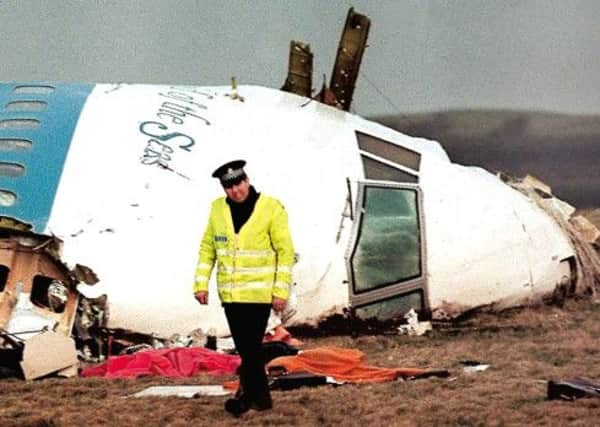Book review: The Professor Of Truth, James Robertson


The Professor Of Truth
James Robertson
Hamish Hamilton, £16.99
SHOULD novelists and other makers of fictions be discouraged from drawing their inspiration from life? Some argue that novels and films drawn from real events muddy the factual waters, pollute collective memory with inaccuracies or even just display poor taste.
Clearly, to bar the practice would be impossible: most writers are drawing from something real most of the time, whether they’re up front about it or not. But objections can be more vociferous when the aspect of real life chosen is a controversial one. Say, one of the biggest crimes the UK has ever seen. Or one of the most significant miscarriages of justice.
Advertisement
Hide AdJames Robertson’s new novel doesn’t name as its subject the explosion of Pan Am Flight 103 over Lockerbie in 1988, or the ensuing legal case against Abdelbaset al-Megrahi, but the parallels are not so much clear as glaring. Robertson, indeed, is hardly ducking them: while his publishers are urging comparison with the thrillers of Graham Greene and John le Carré, he’s sharing promotional events with activists for a reopening of the Lockerbie case.
That’s not necessarily a contradiction. On one level, this is a fictional study of how ordinary people cope with embroilment in crimes and cover-ups perpetrated by states; on another, it’s a piece of campaigning literature, intended to publicise the overt problems with a case which the cross-party bulk of the British political establishment would dearly love to see closed for good. These functions aren’t mutually exclusive. But since some potential readers of a new novel by the author of The Testament of Gideon Mack and And the Land Lay Still may be put off by the prospect of being campaigned at, let’s deal with the first one first.
The Professor Of Truth is not a treatise in novel’s clothing, but a novel, and a very good one at that: at once powered by action and mystery, and profoundly invested in the emotional lives of its characters. The titular professor, an English literature academic named Alan Tealing, is a lovingly drawn and wholly believable creation: widely read, but secretly fearful of intellectual adequacy; private, but forced into a public role by the unsought drama of having lost his wife and daughter in the most high-profile manner imaginable. A slightly dull man who has been briefly transformed by his experience of love and fatherhood, Tealing is now an amateur sleuth, preoccupied day and night by “The Case” even two decades after its main event. His project is not just to bypass official obfuscation and find those really responsible for his loss: it is to replace the energy of his marriage, to keep alive a passion for something, to secure for himself a point to it all.
This is all wonderfully and sensitively evoked, as are Tealing’s encounters along the way with truth-seekers, secret-keepers and minor players alike. Robertson offers up some powerful philosophical asides on truth versus justice, cynicism versus hope, and the nature of romantic love; he also shows his mettle as an effortless evoker of atmospheres, particularly when Tealing’s quest takes him to Australia, and drunkenness, food poisoning, broiling heat and cultural alienation all mingle potently with his jet lag.
The plot can shift on in a slightly jerky manner, but that’s not too unusual within the political thriller genre, and Robertson’s way with character eases the transitions.
What, then, about the book’s relationship to the Lockerbie disaster itself? Well, it made me want to know more. I would guess that conversations took place between Robertson and his publishers about whether to include any material on the real case; and that the decision not to do so was down to a quite reasonable desire to give Robertson’s work a life as fiction.
Advertisement
Hide AdHowever, I’d posit that since the proximity of “The Case” to its real-life counterpart is too extreme to be missed or disregarded – and since the author seems to wish for quite the reverse effect – it would have been useful to the reader to have included some information, even if it was just direction to authoritative factual sources.
Such an addition would both service the curiosity inevitably stimulated by Robertson’s story, and help to emphasise where his book diverges from the real events, in either their official or unofficial versions. For the record, I read a useful précis by Gareth Peirce in the London Review of Books (available online) of the issues raised by campaigners against Al-Megrahi’s conviction, and plentiful further information at Dr Jim Swire’s lockerbietruth.com and Robert Black QC’s lockerbiecase.blogspot.com. (As for a credible defence of the official version – well, good luck sourcing one; many of the bereaved don’t feel that they have yet. This isn’t so much a case of unstable conspiracy theories, as one in which the theories stand strong while the official version falls apart if you breathe on it.)
Advertisement
Hide AdSo should novelists keep their inky hands off real-life tragedies? One answer is that the word “should” has no business intruding on art. Another is that on this evidence, absolutely not: the mingling can produce work that’s both beautiful and important. «
Twitter: @HannahJMcGill